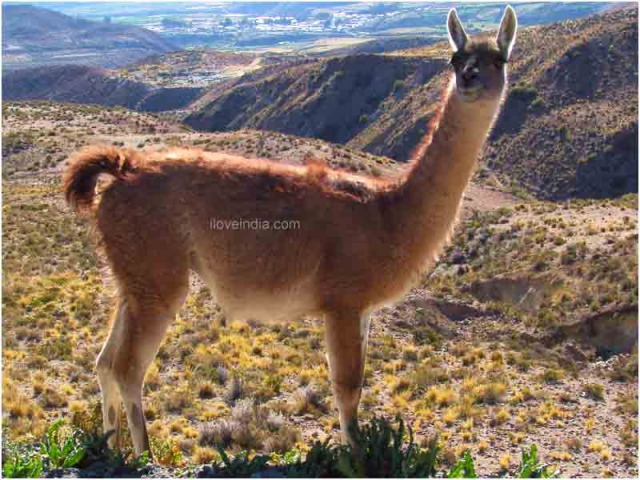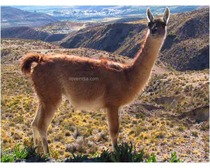Guanacos are graceful animals, with extremely striking large, alert brown eyes; streamlined form & energetic pace. Here, we bring for you some interesting facts and amazing information on guanaco.
Facts About Guanaco
A first look at these strikingly beautiful-eyed animals might make you stubborn with the view that they are camels, but without a lump. However, the fact is that they are guanacos, who belong to the Camelidae family and are native to South America. Guanacos are basically wild animals that are found in Bolivia, Peru, Ecuador, Chile, Argentina and Paraguay. They are not domesticated, but indigenous South Americans use their flesh for food, make their hide into clothing and other coverings and use their bones to make various implements. Guanacos are not picky eaters, surviving on harsh grasses and brush in the wild. They can be easily maintained in captivity and thrive on pasture, a variety of hays, supplemental protein block and an occasional treat of whole grain. Read on to know some more interesting facts and amazing information on guanaco.

Facts About Guanaco
Binomial Name: Lama guanicoe
Kingdom: Animalia
Phylum: Chordata
Subphylum: Vertebrata
Class: Mammalia
Order: Artiodactyla
Family: Camelidae
Genus: Lama
Species: L. guanicoe
Height: 107 to 122 centimeters (3.5 to 4 feet)
Weight: 80- 136 kg (176- 300 pounds)
Life Span: 34 years
Diet: Herbivorous
Range: South America, Bolivia, Peru, Ecuador, Chile, Argentina and Paraguay
Habitat: Arid montane regions and grasslands
Age of Sexual Maturity: Males at 730 days/ Females at 365 days
Gestation Period: 335 days
Number of Offspring: One
Interesting & Amazing Information On Guanacos
- Guanacos are slender animals, without lump and have pale brown backs with white undersides, large heads, very long necks, short tails and big, pointed ears.
- They can get by without water for long periods of time, obtaining moisture from the plants they eat.
- Guanacos are often found at high altitudes, up to 3,962 meters (13,000 feet) above sea level. In order to survive the low oxygen levels found at these high altitudes, a teaspoon of Guanaco blood contains approximately 68 million red blood cells - 4 times that of a human.
- Guanacos live in groups of up to ten females, with their young ones and a dominant adult.
- Bachelor male guanacos can make herds of their own, which can include 50 or more animals.
- Guanacos have specially adapted hearts and blood cells to enable them to live at high altitudes, where the air is short of oxygen.
- Male guanacos challenge each other in fights, by trying to bite each other’s front legs. They also twist their neck together, in the process to establish dominance. The one who wins becomes the leader and the loser has to leave the herd.
- At the age of 5, guanacos leave the bachelor herd and try to lead their own herd of females.
- When a guanaco is upset or annoyed, it spits.
- A young guanaco, known as a chulengo, is able to walk immediately, but the mother can walk in no less than half an hour after giving birth.
- Male calves are chased off from the herd at approximately one year of age. After this, they make a bachelor herd of their own.
- Encroachment on the grazing land of guanacos had once reduced their number drastically; however they emerged from being categorized as endangered to least concerned animals. They thrive on areas protected by law.
- When a guanaco is threatened by a more powerful enemy, like a lion, it makes a high-pitched warning call, causing the other guanacos to flee swiftly and nimbly across the steep and uneven terrain. The herd’s male usually runs behind the rest of the herd.
- A guanaco's coat is a soft, downy fiber covering, which is highly valued for both its rarity and soft texture. A guanaco's soft warm wool is second only to that of its cousin vicuña.
- Llamas and alpacas are believed to be domesticated descendants of guanacos.
- Guanacos can run as fast as 56 kilometers per hour.This is essential for survival, because there are no hiding places in the guanaco's habitat - the only way to escape is to run.
- The pelts, particularly from the calves, are sometimes used as a substitute for red fox pelts, because the difference in texture is difficult to notice.


See also
More from iloveindia.com
- Home Remedies | Ayurveda | Vastu | Yoga | Feng Shui | Tattoos | Fitness | Garden | Nutrition | Parenting | Bikes | Cars | Baby Care | Indian Weddings | Festivals | Party ideas | Horoscope 2015 | Pets | Finance | Figures of Speech | Hotels in India : Delhi | Hyderabad | Chennai | Mumbai | Kolkata | Bangalore | Ahmedabad | Jaipur
- Contact Us Careers Disclaimer Privacy Policy Advertise With Us Lifestyle Sitemap Copyright iloveindia.com. All Rights Reserved.




